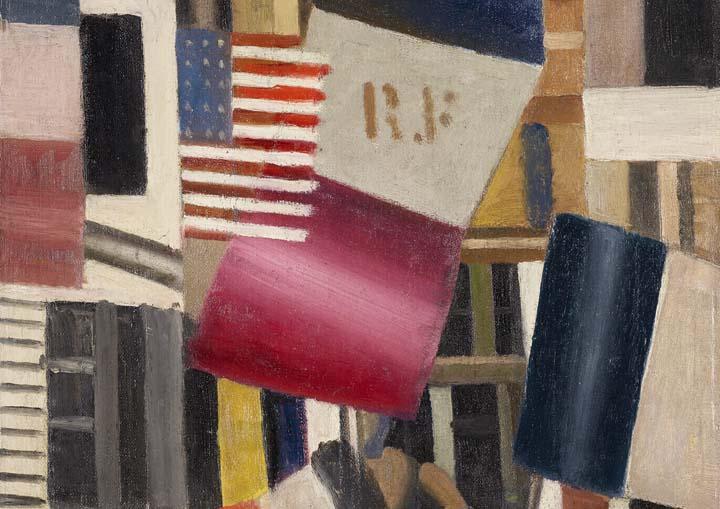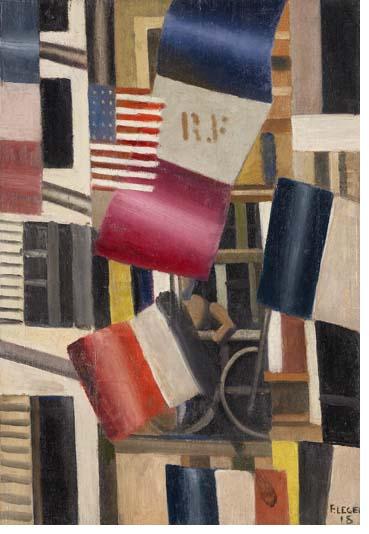Update: Fernand Leger in New York

Fernand Léger was born in 1881 to a family of cattle farmers in Normandy, France. His parents discouraged his interest in art so he initially apprenticed to an architect, in Caen, before moving to Paris in 1900 to pursue his art studies. Although he didn’t get in to the École des Beaux-Artes, he studied classical drawing and painting independently. Influenced by Modernist painters of the time, including Cezanne, Picasso, Braque, and others, Léger began developing his own vocabulary of Cubism. In 1911, his work was included in the first Cubist exhibition, The Salon des Independents, together with works by Francis Picabia and the Villon brothers among others. Above (detail) and below left: Fernand Léger, L’Armistice, 1918; image courtesy of Skarstedt Gallery
From 1914 to 1917 Léger fought on the front-line at Argonne and Verdun. Afterwards he reflected on his experience. “...I was stunned by the sight of the breech of a 75 millimeter in the sunlight,” he wrote. “It was the magic of light on the white metal... The crudeness, variety, humor, and downright perfection of certain men around me, their precise sense of utilitarian reality and its application in the midst of the life-and-death drama we were in ... made me want to paint in slang with all its color and mobility. I wanted brightness and intensity, so I used the machine, as others use the nude or the still life.” This marked a significant change in the work he was making. From abstract and cubist works, Léger transitioned to what became known as his ‘mechanical period’. Industrial and machine-like objects came to the forefront of his artwork.

The works gathered here reflect the full range of Léger’s explorations between 1918 and 1923. Commemorative canvases such as L’Armistice (left) and Le 14 juillet 1918 à Vernon (both 1918) address the memory of conflict and the fragile hope of peace, incorporating uniforms and flags as symbols of resilience and revolution. Industrial and machine-like objects came to the forefront of his abstractions. Equally transformative are his still lifes, where bottles, pipes, and tools are stripped of hierarchy and rendered as mechanized components. In Le déjeuner (1921) and Les trois femmes et la nature morte (1921), the everyday merges with the human figure, suggesting continuity between animate and inanimate forms.
Léger likewise explored this visual language through depictions of entertainment. Le Cirque Médrano (Esquisse) (1918) uses the circus and its lone acrobat to emphasize rhythm, repetition, and mass spectacle over singular identity. The circus becomes, in his hands, a metaphor for the de-individualized yet shared experiences of modern life, as well as an emblem of his belief that art is for everyone—a core value of his that in turn influenced the mid-century Pop Art movement. Skarstedt has produced a catalogue for this show written by art historian Hal Foster, which is available at the gallery. Below: Fernand Léger, The Village, 1914; image courtesy of The Metropolitan Museum of Art

From Skarsted’s 79th Street gallery it’s a quick hop to The Metropolitan Museum of Art, where four of their forty works by Léger are on view, in Gallery 830. To preview the other artwork in the same gallery, go here And if you drift down to MoMA, on West 53rd Street, there are five paintings by Léger to explore, in Gallery 503. For a concise biography of Fernand Léger, please go here
Skarstedt Gallery, 20 East 79th Street, New York, NY Info The Metropolitan Museum of Art, 1000 Fifth Avenue, New York, NY. Info Museum of Modern Art, 11 West 53rd Street, New York, NY Info. 01V112425


